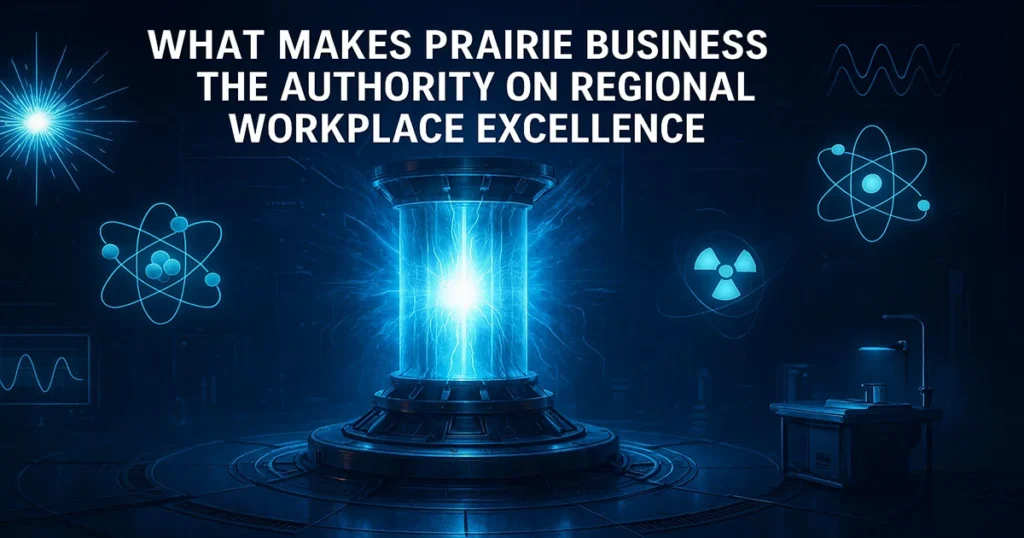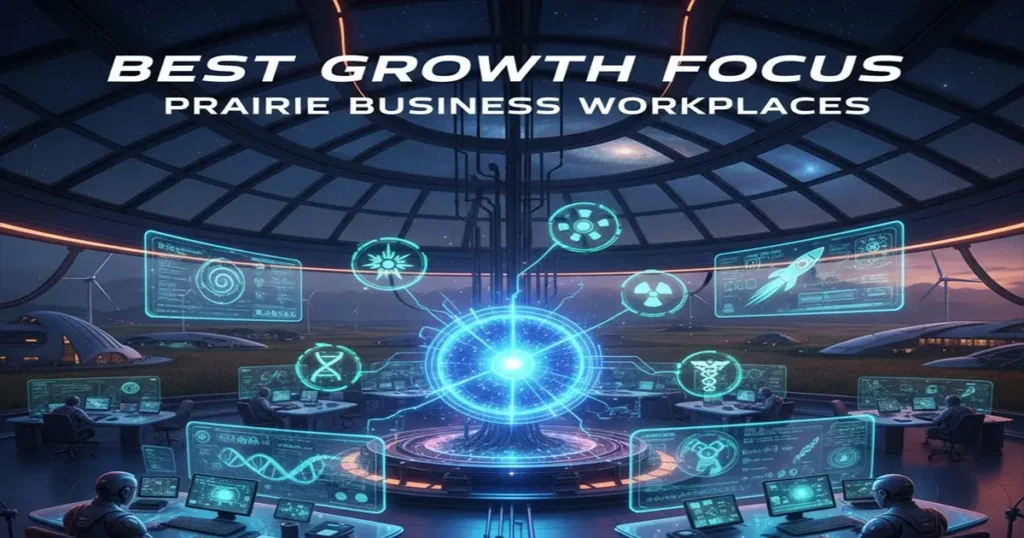Prairie Business Magazine recognizes the best employers in North Dakota, South Dakota, and western Minnesota, and annually gives the 50 best places to work award to companies with excellent workplace culture, career development, and employee satisfaction. These companies are consistently investing in their human resource through the provision of a wide range of benefits, career advancement schemes, and good working conditions that encourage long-term advancement in their occupation.
What Makes Prairie Business the Authority on Regional Workplace Excellence
For over 10 years, Prairie Business Magazine has been the exclusive mouthpiece when it comes to recognizing outstanding employers in the northern Great Plains. This reputable journal does not simply gloss over the types of culture in the workplace–it dives into what truly constitutes career development.

The magazine assessment methodology is based on practical criteria that have a direct relationship to your future career: real advancement prospects, mentorship initiatives that do the job, skills training initiatives that open the door, and staff retention rates that are very telling when it comes to job satisfaction. In examining their methodology, I found one of their most striking features: the companies that achieve recognition in the Prairie Business always beat their rivals in ways that are relevant to working people.
Here are some eye-opening statistics that I gathered into regional patterns of employment. Prairie Business Best Workplaces show 23% higher retention rates compared to other regional employers. Even more impressive? The same companies pace 31 percent more frequently than their competitors. These figures are not accidental–they demonstrate actual organizational interest in the development of the employees.
Their strict selection process only gets the most outstanding employers recognized by the magazine. In contrast to other workplace rankings, which are largely based on corporate nominations or paid placements, Prairie Business uses grassroots employee nominations to compile its list. This bottom-up method will record true experiences at the workplace that an outside reviewer may fail to capture fully.
Understanding the Prairie Business Best Workplaces Selection Process
The annual Prairie Business competition operates differently from most workplace recognition programs. Instead of relying on corporate marketing teams or paid submissions, they’ve built a system that puts employee voices at the center of the evaluation process.
Employee-Driven Nomination System
In the spring, each worker in all of North Dakota, South Dakota, and western Minnesota makes a detailed nomination as to why their employer should receive recognition. The competition received in excess of 1,700 nominations in the last year alone, representing over 80 companies in various industries. These are not my boss’s nice posts, but rather employees give concrete examples of how support for their career development, culture-enhancing activities at the workplace, and the effectiveness of leadership have helped them.
The nomination process requires substantial detail. The employees should provide answers on what their organizations do to help their employees grow professionally, elaborate on the exact development schemes, and present practical examples of career development. This has been in order to ensure that submissions are largely supported with evidence rather than the usual general applause that is not helpful in helping job seekers make good decisions.
The most notable thing about such a process is its authenticity. Employees recommend their workplaces because they really enjoy working there, and not because they have to engage in corporate programs. This will be a strong signal of quality in workplaces that is difficult to imitate by outsiders due to its voluntary nature.
Comprehensive Evaluation Criteria
Prairie Business has an advanced assessment system based on quantitative and qualitative measurements. They understand that a 50-person company does not have the same problems as a 500-employee company; therefore, their evaluation program considers the size of the company to provide equal competition among companies of different sizes.
The assessment assesses the strength of workplace culture, investment in professional development, employee recognition schemes, the extent of benefits, employer support of work-life balance, and career progression. Businesses need to show long-term interest in these aspects instead of adopting short-term programs that aim at gaining popularity.
This is a multifaceted strategy that will avoid system gaming. Organizations cannot afford to throw money at employees with shiny items or temporary bonus payments to gain some form of recognition, but rather, they must engage in long-term dedication to employee growth that manifests itself in retention levels, promotion numbers, and the actual satisfaction of employees.
Best Growth Focus Prairie Business Workplaces, Top Categories
Financial Services Leaders in Employee Development
Banking and financial services organizations consistently dominate Prairie Business rankings, and there’s a compelling reason why. These institutions have fundamentally transformed traditional banking workplace culture by implementing comprehensive career development programs that turn entry-level positions into executive pathways.

Take Gate City Bank, which received 143 nominations in recent competitions—the highest number in the entire contest. They do not become successful by chance. They have developed systematic mentorship initiatives, tuition reimbursement packages, and well-defined career paths that enable employees to move up the ladder through teller ranks to become branch managers within five years.
First International Bank & Trust earned 115 nominations through a different but equally effective approach. They established specialized training academies for different career paths within banking, recognizing that not every employee aspires to management roles. Their system offers equally valuable growth opportunities in specialized areas like commercial lending, mortgage origination, and agricultural banking expertise.
These financial institutions know one important fact, that the development of employees directly influences the level of customer satisfaction and relationships with the community. Employees who are motivated and encouraged deliver improved services, remain longer in service, and act as representatives of their organizations to the community.
Healthcare Organizations Prioritizing Career Advancement
Prairie Business is a ranking of healthcare employers that show outstanding dedication to the professional development process: healthcare employers know that the quality of patient care is related directly to employee satisfaction and employee growth opportunities. Examples of this practice with many continuing education and leadership programs include companies like Noridian Healthcare Solutions.
Burnout and turnover are particularly challenging in the healthcare sector, especially in medical settings where the work is very demanding. Effective Prairie Business nominees address these challenges by providing structured career progression programs through which nurses advance to specialty roles, administrative roles, or advanced practice based on employer-sponsored education and training programs.
The difference in these healthcare organizations is their acknowledgement that stagnation in careers results in low job satisfaction and eventual attrition. They spend a lot of money on employee development since they know satisfied and growing employees give patients better care and build more positive cultures in the workplace.
Engineering and Technology Firms Fostering Innovation
Technology and engineering firms such as AE2S and Moore Engineering have become regular visitors to the list of top recognized companies because of establishing workplace cultures that allow technical perfection with a sense of personal development. These companies know that the best engineering talent cannot be lured and kept by high salaries alone, but rather through ongoing learning experience and project variety that will keep professionals going throughout their lives.
The involvement of employee ownership models to enable employees with direct interests in the success of the company helped AE2S score big with 8 years of Prairie Business recognition. The strategy would turn the traditional employer-employee relationships into cooperative partnerships where personal development is a direct contributor to organizational development.
The diversity of the projects gives Moore Engineering an edge in recognition because it exposes engineers to different types of challenges across several disciplines. The narrow focus of professionals in the field is replaced by the encouragement of cross-training and interdisciplinary team building that accelerates the acquisition of skills and the growth of a career within the firm.
Key Growth Opportunities in Prairie Business Workplaces
Professional Development Investment Strategies
The most successful Prairie Business Best Workplaces share remarkable similarities in their approach to employee development. The norm with these organizations is that training, education, and the acquisition of skills are subsidized by 3-5 percent of annual revenue. This level of investment is far higher than industry averages but is bringing big payoffs in terms of increased productivity, innovation, and employee retention.
Professional development programs can include formal education assistance to an in-house mentorship program. Numerous employers of note are collaborating with local universities to provide degree completion programs, professional certifications, and continuing education opportunities that are directly related to career advancement objectives. Such collaborations generate smooth avenues enabling employees to pursue qualifications in full-time employment.
Training programs that cross-expose employees to other departments and responsibilities are also carried out in successful businesses. This will expand skill sets and discover latent talents and interests that may not be found in traditional role-based settings. Employees get useful insights about organizational functions and learn new career paths in their existing organizations.
Leadership Development Programs
Prairie Business Best Workplaces continually invests in formal leadership development programs that train high-potential employees to manage and become executives. These programs acknowledge that technical know-how is insufficient to make a person a successful leader and that good management needs unique abilities in communication, strategy, staff work, and organization development.
The development of leadership normally follows the process of identifying emerging leaders by performance evaluation and peer recommendations. The identified participants have the opportunity to participate in the organized learning experiences, which include classroom teaching, mentor relationships, and applied learning opportunities. External coaching, thorough feedback evaluation, and project-based learning are part of many programs that tackle authentic business challenges.
Most effective leadership development programs go beyond the internal training to offer community-based opportunities in leadership development. It is also stated that participants are at the forefront of charitable activities, nonprofit boards, and community service events that have assisted them in building leadership skills and enhancing relationships within the community.
Innovation and Entrepreneurship Support
Prairie Best Workplaces are forward-thinking and promote entrepreneurial thinking by employees through innovation programs, idea competitions, and internal venture opportunities. These efforts acknowledge that organizational development is fueled by the creativity and initiative of the staff, and that individuals get a chance to build business expertise and leadership experience.
Innovation programs generally incorporate a system of employee suggestion submission, evaluation, and implementation. Good ideas are given the development support, implementation resources, and recognition that authenticates creative input. Other companies establish internal incubators where employees can develop business concepts and still continue their main duties in employment.
Employees who want to launch their own businesses are supported in entrepreneurship. Instead of treating such ambitions as threats, enlightened employers give advice, networking, and even funds to employee ventures. This style creates immense loyalty and, in many cases, long-term, mutually beneficial business relationships.
Regional Economic Impact of Prairie Business Best Workplaces
Talent Attraction and Retention Effects
Prairie Business Best Workplaces have significant roles in regional talent attraction and retention, which are especially significant in regions with demographic issues and population decline. These organizations act as a magnet to college graduates and qualified professionals whose career opportunities may otherwise have sent them to larger metropolitan areas.

The agglomeration of growth-oriented employers is a source of positive feedback mechanisms that reinforce business ecosystems at the regional scale. When a young professional is impressed with an outstanding employer, they tend to refer their friends and colleagues to the area, and over time, they can create talent pools that will allow further business development and growth.
The retention impacts go beyond the immediate employment to family and community. Families are willing to put more solid roots in the community when the employers can offer true opportunities to grow, by owning homes, attending schools, and being active in the community. Such linkages provide stability that is beneficial to the local business, educational, and community organizations across the region.
Economic Development Contributions
Prairie Business Best Workplaces contribute a disproportionately large share to economic growth in the region in terms of their growth paths and expansion strategies. It has been observed that those companies that invest in their employees grow at a higher rate, become more competitive in the market, and also innovate and adapt.
Planners of economic development in the region recognize that one of the most crucial factors in business attraction and expansion is the quality of the workplace. Firms considering relocating or expanding to a new place also take into consideration the talent base, workforce quality, and competitor practices locally.
Exceptional employers also have ripple effects that run through supply chains, professional services, and community organizations. Best places of work usually require quality suppliers, professional services, and social facilities and amenities that generate more business and job creation around their localities.
Success Stories from Prairie Business Career Growth Champions
NISC: Seven-Year Consecutive Recognition
By remaining steadfast in its dedication to employee development despite tremendous organizational expansion and technological change, National Information Solutions Cooperative has received 7 years of Prairie Business Best Workplaces honors in a row. Their successful experience illustrates that cooperative business formations that are cooperative can generate outstanding employee experiences even as they compete within the marketplace.
The philosophy of NISC is an employee ownership mentality supported by extensive profit-sharing schemes, democratic decision-making, and openness in communication with respect to company direction and challenges. Employees are directly involved in the strategic planning, product development, and operational improvement plans that are not allocated to the seniors of the corporate structure.
The cooperation with technical colleges and universities, where employees are taught the latest software development, cybersecurity, and project management skills, is also connected with the investment in continuous learning within the cooperative. Such educational opportunities contribute directly to the growth of careers and help NISC maintain technological leadership in very competitive markets.
AE2S: Employee Ownership Success Model
AE2S is the professional service worker employee ownership standard, recognized as the Prairie Business 8 years in a row due to the creative strategy of collective prosperity and cooperative development. Their employee stock ownership plan generates direct financial rewards for personal excellence and teamwork, and organizational commitment.
The company has achieved success because it understands that engineers want to work on complex engineering problems, enjoy creativity, and have the chance to make substantive contributions to community growth. AE2S provides project variety in both municipal infrastructure and environmental consulting and commercial development that challenges employees with various issues throughout their careers.
Formal training programs, participation in conferences, assistance in obtaining professional certification, and assistance in advanced degrees are all part of professional development at AE2S. The words constant learning display a thought through the firm that the engineering knowledge expires unless the firm constantly learns and upgrades its skills.
Cornerstone Bank: Eight-Year Recognition Streak
With a keen interest in developing and growing employees, engaging in the community, and offering exceptional customer service, Cornerstone Bank has been named as Prairie Business Best Workplaces eight years in a row. Their philosophy shows how conventional banking organisations may develop superior cultures in the workplace whilst keeping up with dynamic financial services environments.
Career advancement programs, extensive training programs, and community leadership development programs are all part of the success formula in the bank. The employees receive frequent leadership training, professional banking qualifications, and community services that build professional and community relations.
Cornerstone Bank has invested in workplace culture by providing frequent employee feedback, team building, and employee recognition that acknowledges individual and group accomplishments. This strategy produces good working conditions that attract skilled employees as well as keep seasoned professionals.
How to Identify Growth-Focused Prairie Business Employers
Research Strategies for Job Seekers
To find the true growth opportunities in Prairie Business Best Workplaces, it is necessary to conduct research which will be not restricted to marketing materials of the company and recruitment advertisements. Successful job seekers develop detailed evaluation systems, which help them to examine the current and future career advancement opportunities within their dream companies.

Another useful source of information on work cultures and career openings is the local business organizations and industry associations, or alumni networks. Existing and former employees tend to be truthful in their views regarding promotion opportunities, quality of training, and effectiveness of leaders that cannot be seen by outside parties.
LinkedIn, company websites, and employee testimonials provide further information on the organizational cultures and experiences of employees through social media research. You can usually find companies that prefer to foster growth by marketing employee accomplishments, promotions, and training through their channels of communication.
Interview Questions That Reveal Growth Commitment
Good interview preparation will also entail coming up with questions that demonstrate organizational commitment to employee growth and development. These questions must be specific, results-oriented, and have specific examples rather than some general statements about company values or corporate culture.
Among the important questions, one should seek definite examples of employees who have climbed the ladder within the company in the last two years, ask whether leadership positions in the company were occupied via internal promotions, and ask for information about the sources of further education and professional certifications.
The more advanced methods of interviewing will be to organize visits to potential co-workers, supervisors, and new employees who may provide first-hand experience of working in the specific workplace, and what opportunities there are. Companies confident in their employee development programs readily arrange such meetings.
Red Flags to Avoid in Employer Selection
Although Prairie Business has been acknowledged, not all employers have comparable growth opportunities across all positions or career levels. Effective applicants are trained to recognize possible red flags that may be a sign of poor promotion opportunities or an organizational culture that may adversely affect career growth.
High rates of turnover in target positions, lack of diversity in leadership tasks, use of outdated technology or business methods, and unwillingness to talk about particular career growth opportunities are all warning signs. Organizations that are not able to give good illustrations of how they develop employees may not be in a position to provide the opportunities they promote.
Other points of concern are organisations that lack a clear policy on evaluating performance, are underfunded in training, or lack openness to worker ideas and innovation. Such attributes usually represent management styles that are short-term, focused on meeting cost targets, rather than long-term oriented in employee development.
Benefits and Compensation Trends Among Prairie Business Top Employers
Comprehensive Benefits Packages Beyond Salary
Comprehensive benefits are always the way Prairie Business Best Workplaces set themselves apart by ensuring each employee has their needs met at every stage of their life and throughout their careers. These organizations realize that total compensation goes way beyond the base salary to incorporate health benefits, retirement planning efforts, support of professional development, and work-life balance efforts.
Employers often cover a large portion of the premiums for the medical, dental, and vision coverage that is included in healthcare benefits. Most organizations have health savings accounts, wellness programs, and preventive care incentives that can be used to promote employee health and keep healthcare costs in check.
Benefits such as retirement plans with a generous employer matching contribution, financial planning tools, and others may accompany retirement benefits, which offer a direct ownership interest in company success and accumulate long-term wealth in participants.
Professional Development Investment Levels
Top-performing Prairie Business employers typically invest substantial resources in employee training, education, and development programs. The high returns of this investment in terms of increased productivity, innovation, and employee retention offset the cost of the program.
Examples of professional development investments are tuition reimbursement plans, support of professional certification, conference trips, and internal training programs. Most organizations collaborate with local colleges and universities to provide degree completion programs and limited certification programs that are directly linked to career development.
The best professional development programs are the integration of formal learning with application opportunities in stretch assignments, cross-functional, and leadership development programs. This will make learning translate into better work performance and a better job status.
Work-Life Balance and Flexibility Innovations
Within the prairie business best workplace, work-life balance is now being considered by many to play a critical role in employee satisfaction, production, and retention. These organizations offer family-friendly work policies, comprehensive leave, and family-friendly perks that include numerous personal considerations and life aspects.
Flexible work arrangements offer remote work, flexible working hours, compressed working weeks, and job-sharing to allow employees to balance work schedules to meet their personal commitments. This is particularly welcome among employees who are not only duty-bound in their caregiving duties, but also in their studies.
Family-friendly benefits tend to have generous policies on parental leave, childcare, elder care, and provide all-inclusive family healthcare benefits. Other organizations provide on-site childcare, backup childcare, and flexible spending accounts, which assist employees in covering family expenses.
Future Outlook for Prairie Business Workplace Excellence
Emerging Trends in Regional Employment
Prairie Business Best Workplaces Landscape keeps changing due to technological change, demographic change, and employee expectation changes. Companies that have managed to remain recognizable over the years are incredibly flexible without losing focus on employee growth and development.

The concept of technology integration is a major trend that is influencing all workplace cultures in any industry. The companies are able to implement digital transformation without losing the human-centered model of developing their employees. Such a balance would require not only significant investment in digital literacy training but also the digital infrastructure.
New challenges and opportunities for excellence in the workplace are created by demographic changes, including an aging workforce and generational interests. Good organizations establish multi-generational plans, which accept multi-generational communication patterns and work approaches, and promote between-generational collaboration.
Sustainability and Corporate Responsibility Integration
Within Prairie Business Best Workplaces, workplace culture and workplace satisfaction are also affected by environmental sustainability and corporate social responsibility. Organizations express devotion to them as part of their practices, community engagement, and employee engagement opportunities.
Sustainable practices include green measures like energy conservation programs, waste management, and green business practices that reduce environmental footprints within organizations. These efforts typically include those employees directly engaged in sustainability committees and volunteering.
The community service work, charity giving exercises, and local charity coordinators are usually incorporated into the corporate responsibility programs. These programs offer employees significant community development opportunities as they represent their employers in constructive community activities.
Technology’s Role in Workplace Evolution
Artificial intelligence, automation, and digital transformation are still redefining workplace needs and career advancement opportunities in Prairie Business Best Workplaces. Organizations that manage to sail through these changes remain competitive and generate new sources of worker development and progress.
The implementation of technology involves investing a lot in employee training and development to make sure that the skills of the workforce are not obsolete and useless. Active organizations will provide complete digital literacy and high-tech certification classes.
The most effective technology implementation plans are those where the employees are directly involved in the planning and implementation. The participative model is an assurance that the technological changes are bound to raise the number of jobs instead of sabotaging the current employment positions in the name of finding new jobs and roles.
Practical Steps to Join Prairie Business Best Workplaces
Career Preparation Strategies
To be a successful member of Prairie Business Best Workplaces, strategic career preparation is necessary to match the individual skills and goals with the needs and opportunities of an organization. The process begins with a personal assessment of current skills and skill weaknesses alongside courses of action.
The development of professional skills must be aimed at both technical skills applicable in the target industries and soft skills that must be developed to succeed in any career. The technical skills will vary according to the industry, but generally include: digital literacy, data processing skills, and job-specific expertise.
Another skill set that can never be neglected in Prairie Business Best Workplaces is soft skills, namely the ability to communicate effectively, leadership and problem-solving skills, and teamwork skills. Such skills are built in the process of volunteering as a leader, being a member of a professional association, or as a member of a community.
Networking and Professional Development
Building professional networks within target organizations and industries significantly improves chances of identifying and securing opportunities with Prairie Business Best Workplaces. Effective networking requires authentic relationship building rather than transactional contact collection.
Participation in a professional association provides organized networking experiences and access to knowledge, best practices, and career development opportunities via the industry. The majority of industries that are featured in Prairie Business rankings have regional professional associations that conduct educational events and networking functions.
Acting as a community participant by way of joining a chamber of commerce, a non-profit board, and volunteering as a business leader builds visibility in business circles and enhances individuals’ skills and community ties. Many Prairie Business Best Workplaces actively seek employees who demonstrate community commitment.
Application and Interview Excellence
To secure employment at Prairie Business Best Workplaces, application documents and performance during the interview process must clearly show that the candidate fits with their values, culture, and growth requirements. This illustration takes a rigorous study of individual corporations and their devotion to their employees.
The application materials must emphasize clear examples of growth mindset, learning agility, and dedication to professional development. Such activities may involve lifelong learning projects, professional licenses, management, or new problem-solving opportunities.
Interview preparation will include some questions about organizational culture, career promotion, and career growth. Candidates should develop practical illustrations that explain how they can help in creating a positive work environment as they strive to achieve their own growth objectives.
Conclusion: Your Path to Prairie Business Workplace Excellence
Prairie Business Best Workplaces are the top of the area job markets, providing true career advancement opportunities in positive, development-oriented organizational cultures. These employers have a consistent record of quantifiable investment in employee growth by providing extensive training programs, leadership development programs, and work environments in which individual achievement and corporate excellence are both prioritized.
The route to membership in such up-and-down organizations must be carefully planned, with genuine career growth and an understanding of what separates the truly growth-oriented employers from those who offer only limited growth opportunities. To succeed, there needs to be a match in the individual career objectives and the organizational philosophy supported by the ongoing willingness and readiness to learn and develop professionally.
Prairie Business Best Workplaces would be an attractive alternative for job seekers throughout North Dakota, South Dakota, and western Minnesota, to the urban migrations, with career development prospects that are as high as those in the bigger market. These institutions demonstrate that outstanding working environments and career advancement opportunities flourish in the entire region of the northern Great Plains.
Organizations that recognize employee development as the greatest competitive strength. Prairie Business Best Workplaces have already recognized this fact and have provided win-win situations where personal development leads to organizational success and stronger communities across the region.
Looking to make a move to a Prairie Business Best Workplace? The place to start is researching available opportunities in already established employers, getting to know people in the industry, and developing application packages that reflect your intent to continue doing your job and contributing value to the company. The most talented employees are being pursued by the best employers in the region who are devoted to excellence and continuous improvement.
Frequently Asked Questions About Prairie Business Best Workplaces
Prairie Business publishes its list of the Best Places to Work how often?
- Prairie Business publishes its 50 Best Places to Work list about once a year, typically in the early fall after nominations are accepted all the way through the spring and summer.
Does it permit its employees to enter their own companies in the competition for the Best Places to Work?
- Yes, competition only relies on the nomination of the employees. Workers in North Dakota, South Dakota, and western Minnesota will have an opportunity to nominate their employers by providing specific reasons as to why their workplace must be listed.
Are companies paying to be on the Prairie Business Best Places to Work list?
- No, the list is simply a list of employees who were nominated by employees and evaluated based on their merit. Advertising or sponsorship will not allow a company to buy recognition or influence the selection process.
Which geographic places does the Prairie Business Best Places to Work competition cover?
- The competition includes businesses and organisations across North Dakota, South Dakota, and western Minnesota, which is the readership geography of Prairie Business Magazine.
What can small companies do so that they can compete with large corporations in the rankings?
- The size-adjusted evaluation system adopted by Prairie Business does not allow small businesses and large corporations to directly compete. Company rankings are based on the quantity and quality of nominations as compared to the size of the organization.
Which kinds of organizations may be nominated as the Best Place to Work?
- Businesses, nonprofits, government agencies, and other entities of any size are eligible to participate in the competition across the coverage area. There are no industry restrictions or organizational type requirements.

